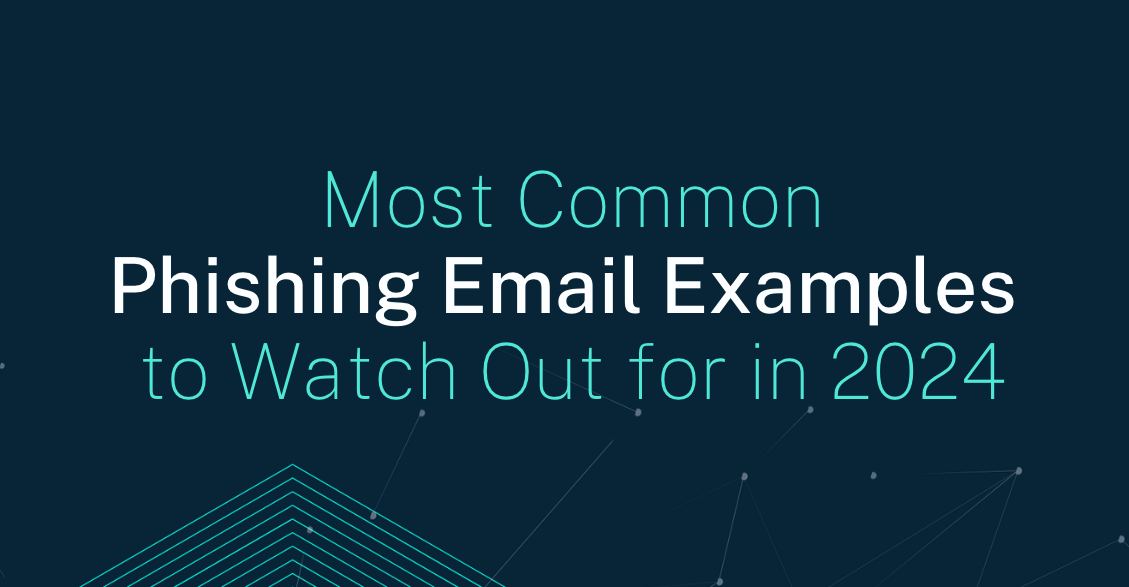

Blogs 
March 7, 2024
Most Common Phishing Email Examples to Watch Out for in 2024

In 2024, the digital landscape continues to evolve rapidly, bringing with it an alarming rise in phishing scams. These scams not only pose a significant threat to individuals but also to businesses, affecting their operations and compromising sensitive data. The sophistication and creativity behind these fraudulent activities have made it increasingly difficult for users to distinguish between legitimate communications and malicious attempts. This underscores the importance of being vigilant, informed, and educated about these scams to protect oneself and one's organization effectively. In this article, we will delve into the most prevalent phishing scams of 2024, identifying their common characteristics, and providing practical strategies to avoid falling victim. From fake invoice scams to sophisticated employment frauds, we aim to arm you with the knowledge to recognize and respond to these threats proactively, enhancing your cybersecurity posture. By examining these phishing email examples, we'll illustrate the tactics used by scammers, making it easier for you to spot and avoid them.
1. Fake Invoice Scam
Fake invoice scams trick recipients into paying for nonexistent services or products, or inflating the cost of real ones. These emails often mimic legitimate invoices from well-known vendors or service providers but contain fraudulent payment details. Common characteristics include unexpected invoices, mismatched details, urgent payment requests, and the misuse of corporate logos to appear legitimate. To avoid falling victim to this scam, we recommend verifying the authenticity of the invoice by contacting the vendor directly through official channels, rather than responding to the email or clicking any links. Always scrutinize the details such as the sender's email address, invoice number, and the product or service listed to ensure their legitimacy.
2. Email Account Upgrade Scan
These scams prey on the need for regular account maintenance, luring victims with the promise of necessary email upgrades or increased storage. The danger lies in the redirects that accompany these emails, which can lead to phishing sites designed to harvest login credentials. To protect yourself, it is crucial to verify the authenticity of such requests by directly contacting your email service provider and refraining from providing personal information through unsecured channels. Educate yourself and your team on the latest security protocols to safeguard your email accounts against such deceptive tactics. Incorporating phishing awareness training into your organizational culture can significantly mitigate these risks.
3. Advance-Fee Scam
Advance-fee scams entice victims with the promise of receiving a large sum of money in return for a small upfront fee. These scams leverage the appearance of legitimacy and urgency to compel victims to act. Recognizing the red flags of these too-good-to-be-true offers is essential, and we advise a healthy skepticism and independent verification before proceeding with any transaction that seems suspicious. Remember, legitimate companies or entities will never ask for an upfront fee to receive a prize or a large sum of money. This tactic is a common example of how scammers exploit human psychology, underlining the importance of phishing prevention measures.
4. Google Docs Scam
This scam involves a link that takes you to phishing websites designed to steal login credentials when clicked. The sophistication of these scams lies in their ability to mimic real Google notifications convincingly, complete with accurate logos and formatting. To handle document sharing requests securely, always verify the sender's identity and access documents directly through the official Google Docs site, rather than by clicking on links in emails. Be particularly wary of unsolicited document shares or requests from unfamiliar email addresses. Educating employees on phishing scenarios involving document sharing platforms can greatly reduce susceptibility to these types of attacks.
5. Dropbox Scam
Scammers use Dropbox-themed emails to disseminate malware or phish for personal information. Key red flags include unsolicited sharing requests, unexpected download links in emails, and the improper use of Dropbox logos to create a false sense of security. Adopting safe file-sharing practices and verifying the legitimacy of any unexpected request through official Dropbox channels can significantly reduce the risk of falling prey to these scams. Ensure that your Dropbox account is secured with two-factor authentication and educate your network on the importance of confirming the authenticity of shared files.
6. Employment Scam
Targeting job seekers, these scams offer fake employment opportunities to extract personal or financial information. Spotting fraudulent job offers involves scrutinizing email addresses, job descriptions, and the application process for inconsistencies. Verifying the legitimacy of job offers through official company channels is a critical step in protecting oneself against these scams. Always be cautious of offers that seem too good to be true, especially if they require personal information or payment upfront. The inclusion of corporate logos in emails does not guarantee authenticity; it's directed at convincing you of the legitimacy of the offer. Such phishing scenarios underscore the need for continuous phishing awareness training.
7. 'Account Suspended' Alert
By falsely claiming an account suspension, scammers create a sense of urgency to provoke a hasty response. It's vital not to react impulsively to such emails and independently verify your account status through official and secure channels. This scam often includes a link that takes you directly to a phishing site where you're prompted to enter credit card information or personal details to "reactivate" your account. Never use the links or contact details provided in the suspicious email; instead, go directly to the service's official website or contact customer support through verified means. This example highlights the critical role of phishing prevention strategies in safeguarding personal and financial information.
8. Fake IT Alert
Posing as urgent IT alerts, these scams may warn of fake virus infections or security breaches to elicit immediate action. Establishing clear protocols for IT communications within your organization can help distinguish genuine alerts from fraudulent attempts. Encourage a culture of security awareness, where employees feel comfortable questioning and verifying the authenticity of alarming IT communications through established internal channels. This scam often lacks personalized salutations, a red flag for phishing attempts aimed at compromising your information security. A robust phishing prevention framework can help mitigate the impact of these scams on your organization.
9. Tax Refund Scam
Mimicking communications from tax authorities, these scams risk personal information exposure and financial loss. Always verify tax-related communications directly with the relevant authorities before responding to any unsolicited emails or messages. Be aware that tax agencies typically do not initiate contact with taxpayers via email for personal or financial information. Familiarize yourself with the official communication channels of your local tax authority to prevent falling for these scams, which threaten your information security.
10. CEO Phishing Email
Impersonating company executives, these scams solicit sensitive information or unauthorized financial transactions. Implementing internal verification processes can safeguard against these deceptive tactics. Encourage an environment where it's acceptable to verify unusual requests, even if they seem to come from high-level executives. This can involve direct confirmation through a known phone number or another secure method of communication. The use of familiar logos and executive names in these emails is designed to bypass your critical thinking and prompt you to act without verification.
11. HR Email Scam
Scammers posing as HR personnel may attempt to gather personal or financial information under false pretenses. Employees should cross-check and verify any unusual HR requests through known, official channels. It's crucial to maintain a skeptical attitude towards unexpected emails requesting sensitive information, even if they appear to be from within the company. Regular training sessions on phishing awareness can help employees recognize and respond appropriately to such attempts, reinforcing the organization's information security framework.
12. Suspicious Activity Alert
Alerting victims to fake suspicious activities, these scams use fear tactics to prompt immediate action. Developing strategies for independently verifying such alerts can protect against these fraudulent schemes. Always pause to assess the situation and reach out to the institution or service provider through official means to confirm any claims of suspicious activity. This proactive approach can significantly reduce the risk of falling victim to phishing attempts designed to exploit your fears and compromise your information security.
Protect Yourself and Prevent Phishing with Living Security
This article has explored the multitude of phishing scams proliferating in 2024, each with its unique methods and deceptive practices. The key to defending against these threats lies in security awareness, education, and the implementation of robust verification processes. Living Security is at the forefront of combating these scams, offering cutting-edge solutions and training programs designed to enhance your cybersecurity defenses. By incorporating our strategies and solutions into your data security practices, you can significantly reduce the risk of phishing attacks and protect your valuable information. We invite you to take action today and join us in the fight against cyber threats, ensuring a safer digital environment for all.